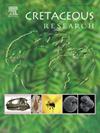Theropod teeth from the Upper Cretaceous of central Spain: Assessing the paleobiogeographic history of European abelisaurids
IF 1.7
3区 地球科学
Q1 GEOLOGY
引用次数: 0
Abstract
The upper Campanian–lower Maastrichtian site of Poyos (Guadalajara, Spain) has yielded an abundant fossil record of reptiles, including several cranial and postcranial elements of theropod dinosaurs. Here we present a study, based on statistical and cladistic analyses as well as on detailed description, of a sample of isolated theropod teeth collected from this site. The sample comprises twenty relatively complete and well-preserved tooth crowns, belonging to mesial and lateral teeth. The combination of morphological and morphometric features is consistent with the identification of these specimens as belonging to a medium-sized abelisaurid theropod. These specimens resemble the teeth associated with the holotype of Arcovenator escotae (upper Campanian of France) and some isolated teeth assigned to Arcovenator sp. from different temporal correlative localities of Spain. These similarities suggest the presence of an abelisaurid closely related to Arcovenator in Poyos, expanding the fossil record of this lineage of abelisaurids to the upper Campanian-lower Maastrichtian in the Iberian Peninsula. The currently known fossil record shows that abelisaurids were one of the most abundant groups of non-coelurosaurian theropods in the Upper Cretaceous of Europe and possibly the only medium-to large-size carnivorous dinosaurs in the Ibero-Armorican realm from the upper Cenomanian to the upper Maastrichtian. The increasing abundance of abelisaurids during the Late Cretaceous and the vanishing of other large theropods that dominated the Early Cretaceous faunas of Ibero-Armorica seem to be part of a faunistic turnover that can be related to a climate change to semi-arid conditions.

西班牙中部上白垩纪兽脚亚目恐龙牙齿:评估欧洲阿贝利龙的古生物地理历史
Poyos(西班牙瓜达拉哈拉)的上坎帕尼亚-下马斯特里赫特遗址发现了大量的爬行动物化石记录,包括一些兽脚亚目恐龙的颅骨和后颅骨成分。在这里,我们提出了一项研究,基于统计和分支分析以及详细描述,从该地点收集的分离兽脚亚目动物牙齿样本。样本包括20个相对完整且保存完好的牙冠,分别属于中牙和侧牙。形态学和形态计量学特征的结合与这些标本属于中型阿贝利龙兽脚亚目的鉴定一致。这些标本与Arcovenator escotae(法国上坎帕尼亚)的全型牙齿相似,与西班牙不同时间相关地区的Arcovenator sp.的一些分离牙齿相似。这些相似性表明,在波约斯存在一种与Arcovenator密切相关的阿贝利龙,将这一阿贝利龙谱系的化石记录扩展到伊比利亚半岛的上坎帕尼亚-下马斯特里赫特。目前已知的化石记录表明,阿贝利龙是欧洲上白垩纪最丰富的非骨龙类兽脚亚目恐龙群之一,可能是伊比利亚-阿莫里亚地区从上塞诺曼尼亚到上马斯特里赫特的唯一中型到大型食肉恐龙。白垩纪晚期阿贝力龙数量的增加,以及其他在伊比利亚-阿莫里卡早白垩纪动物群中占主导地位的大型兽脚亚目恐龙的消失,似乎是动物群更替的一部分,这可能与气候向半干旱条件的变化有关。
本文章由计算机程序翻译,如有差异,请以英文原文为准。
求助全文
约1分钟内获得全文
求助全文
来源期刊

Cretaceous Research
地学-地质学
CiteScore
4.10
自引率
19.00%
发文量
235
审稿时长
12 weeks
期刊介绍:
Cretaceous Research provides a forum for the rapid publication of research on all aspects of the Cretaceous Period, including its boundaries with the Jurassic and Palaeogene. Authoritative papers reporting detailed investigations of Cretaceous stratigraphy and palaeontology, studies of regional geology, and reviews of recently published books are complemented by short communications of significant new findings.
Papers submitted to Cretaceous Research should place the research in a broad context, with emphasis placed towards our better understanding of the Cretaceous, that are therefore of interest to the diverse, international readership of the journal. Full length papers that focus solely on a local theme or area will not be accepted for publication; authors of short communications are encouraged to discuss how their findings are of relevance to the Cretaceous on a broad scale.
Research Areas include:
• Regional geology
• Stratigraphy and palaeontology
• Palaeobiology
• Palaeobiogeography
• Palaeoceanography
• Palaeoclimatology
• Evolutionary Palaeoecology
• Geochronology
• Global events.
 求助内容:
求助内容: 应助结果提醒方式:
应助结果提醒方式:


